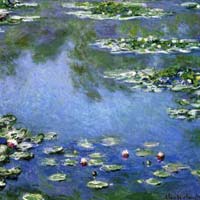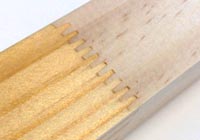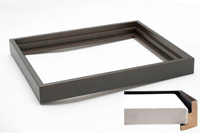| Glossary Of Giclee Terms
[25] |
F
F-stop F-stop, also known as f-number or aperture value, is a numerical measurement that indicates the size of the aperture opening in a camera lens. It represents the ratio of the lens's focal length to the diameter of the aperture opening. Lower f-stop values indicate larger aperture openings, which allow more light to pass through the lens and reach the camera sensor or film, resulting in brighter exposures and shallower depth of field. Higher f-stop values indicate smaller aperture openings, which reduce the amount of light and increase depth of field. F-stop settings control exposure, depth of field, and image sharpness in photography. |
| Face-mounted Face-mounting is a process used in fine art printing and display where a print is adhered to the back of a transparent material, such as acrylic or glass, using a clear adhesive. This creates a smooth, glossy surface on the front of the print, enhancing its visual impact, depth, and vibrancy. Face-mounted prints are valued for their modern and sleek appearance, as well as their durability and resistance to fading, moisture, and damage. Face-mounting is commonly used for displaying Giclée prints, photographs, and artwork in galleries, exhibitions, and commercial settings. |
| Fade(ing) To lose or cause to lose brightness or brilliance or definition of line, form and color. |
Fading Fading refers to the gradual loss or alteration of colors, tones, or image detail in a printed or displayed image over time due to exposure to light, heat, humidity, pollutants, or other environmental factors. Fading can occur in both analog and digital prints, affecting the visual quality and longevity of the printed image.
Factors such as ink type, paper quality, display conditions, and protective coatings can influence the rate and severity of fading. To minimize fading in Giclée printing, archival-quality materials, pigment-based inks, UV-resistant coatings, and proper display techniques are often used to ensure long-lasting print durability and color stability. |
Fast Color Ink This term refers to inks that are "color fast", meaning they retain the density of their color and do not fade despite washing and excessive handling.
Depending on the ink, color fast may imply UV fade-resistant |
| Feathering Feathering, also known as softening or blending, is a digital image editing technique used to create smooth and seamless transitions between adjacent areas of an image. It involves selectively blurring or blending the edges of a selection or mask to reduce or eliminate harsh transitions and create a more natural and aesthetically pleasing effect. Feathering is commonly used in techniques such as image compositing, retouching, and selective adjustments to blend elements together seamlessly and achieve professional-looking results in Giclée printing and digital photography. |
| Felt Marker A felt marker, also known as a felt-tip pen or marker pen, is a writing or drawing tool with a porous tip made of compressed felt or fiber material. Felt markers are commonly used for creating bold, expressive lines and vibrant colors on various surfaces, including paper, cardboard, plastic, and fabric. They come in a wide range of colors, tip sizes, and ink formulations, making them versatile tools for sketching, coloring, lettering, and illustration. In Giclée printing, felt markers may be used for hand-drawn artwork or annotations on printed images before scanning or digitization. |
Fiber Paper Used in the creation of photographic prints, fiber-based papers are coated with a substance called baryta (a mixture of barium sulfate and strontium). This treatment brightens the paper, or tints may be added to subtle color. Fiber paper usually has a gelatin layer as well, which protects the paper during processing. Most often, these kinds of paper are used when the photographer requires high-quality, long lasting prints for exhibition or sale.
Fiber-based papers are also available for digital printing, considered ideal for producing beautiful black and white photographic images with excellent grey tones. Baryta is added to the ink-receptive coating in order to achieve the same effect as traditional papers. |
Filter In photography, a filter is an optical accessory that is placed in front of the camera lens to modify or enhance the appearance of the image by altering the color, contrast, or light transmission properties of the incoming light. Filters can be made of glass, plastic, or gelatin and come in various types, such as color filters, neutral density filters, polarizing filters, and special effects filters.
Each type of filter serves a specific purpose, such as correcting color temperature, reducing glare, intensifying colors, or creating artistic effects. Filters are commonly used in landscape photography, portrait photography, and studio photography to achieve desired visual effects and creative interpretations in Giclée printing. |
| Fine art Any of the visual arts, including painting, drawing, printmaking, sculpture and some performance art. The term generally excludes other art forms such as poetry, literature, dance and music. |
 |
Fine Art Paper Fine art paper, also known as art paper or archival paper, is a high-quality paper substrate specifically designed for printing fine art reproductions, photographs, and digital artwork. It is characterized by its excellent print quality, longevity, and ability to reproduce rich, vibrant colors and intricate details with exceptional clarity and precision.
Fine art papers come in a variety of textures, weights, finishes, and compositions, including cotton rag, alpha cellulose, and specialty papers such as matte, glossy, satin, and textured surfaces. Fine art papers are commonly used in Giclée printing for producing museum-quality prints that meet the highest standards of durability, aesthetics, and archival preservation. |
Fine Art Papers There is a huge variety of fine art papers available for digital printing. Much like fabrics, they vary depending on their intended application and the printer/ink that will be used to produce them. These papers will almost always be archival or conservation quality, which means they are free from acid, chlorine, and lignin (a natural polymer found in wood that causes deterioration), and buffered to achieve a neutral pH prior to being coating for the printer.
Fine art paper is generally 100% cotton, though cotton blends do exist. It is available in many different surface textures from smooth to as rough as watercolor paper, and finishes such as matte, satin, and gloss. The color of the paper will also vary by material and manufacturer, from a cool blue-white to a soft, almost off-white.
Order online: Fine Art Prints |
Fine Art Photography Fine art photography refers to a genre of photography that emphasizes creative expression, aesthetic quality, and artistic vision, rather than simply documenting subjects or events. Fine art photographers use photography as a medium for self-expression, exploration of concepts, and communication of ideas, often employing techniques such as composition, lighting, framing, and post-processing to create visually compelling and emotionally resonant images.
Fine art photography encompasses a wide range of subjects, styles, and approaches, including landscapes, portraits, still life's, abstracts, and conceptual art. Prints of fine art photographs are commonly produced using high-quality materials and printing techniques, such as Giclée printing, to preserve the integrity and artistic intent of the original images. |
Fine Art Reproduction The process of photographing or scanning original artworks and digitally color matching them, and then printing copies with a high quality - usually giclée - printer on conservation-grade (archival) paper or canvas.
We offer high quality fine art print reproductions of your favorite artwork. |
| Finger-jointed Refers to the way pieces of molding and stretcher bar wood are connected. Shorter pieces joined by thin, interlocking teeth will produce a straighter, stronger length than a long, complete beam of wood. This method also reduces the waste of smaller wood pieces. |
 |
| Finishing The final processes in preparing a fine art print or wrapped canvas for display. This may include fitting the artwork into the frame, attaching hanging hardware and affixing dust covers or cloth tape to the back of the frame. |
| Fixative A fixative is a chemical solution applied to a finished artwork or print to protect the surface, prevent smudging, and enhance durability. Fixatives are commonly used in traditional drawing, painting, and printmaking techniques to seal and stabilize the media, such as charcoal, pastels, graphite, and ink, and prevent them from smudging or rubbing off. Fixatives come in various formulations, including aerosol sprays, brush-on liquids, and archival varnishes, each offering different levels of protection and compatibility with different media and substrates. In Giclée printing, fixatives may be applied to printed images on paper or canvas to enhance longevity, resistance to handling, and overall print quality. |
| Flare Flare refers to unwanted stray light that enters the camera lens and causes glare, haze, or reduced contrast in a photograph. Flare can occur when bright light sources, such as the sun or artificial lights, shine directly into the lens or bounce off reflective surfaces, such as glass or water. Flare can manifest as ghosting, veiling glare, or lens flare artifacts, depending on the angle, intensity, and position of the light source relative to the camera lens. To minimize flare in photography, photographers may use lens hoods, lens filters, or shading techniques to block stray light and improve image contrast and clarity. In Giclée printing, flare artifacts may be visible in printed images if not properly corrected during the image editing or printing process. |
| Flash Memory Card A flash memory card is a solid-state storage device used for storing digital data, such as photographs, videos, music, and documents. Flash memory cards use non-volatile memory chips to store data, allowing for fast read and write speeds, high reliability, and compact form factors. Common types of flash memory cards include Secure Digital (SD), CompactFlash (CF), microSD, and Memory Stick, each offering different storage capacities and transfer speeds. Flash memory cards are commonly used in digital cameras, camcorders, smartphones, tablets, and other electronic devices for storing and transferring digital media files. |
| Flash Sync Flash sync, also known as flash synchronization, refers to the coordination of a camera's shutter speed with the firing of an external flash unit to ensure proper exposure and synchronization of flash and ambient light. Flash sync is important for preventing motion blur and achieving consistent lighting in flash photography, particularly when using high-speed flash units or capturing fast-moving subjects. Different cameras have specific flash sync speeds, typically ranging from 1/60 to 1/250 of a second, which represent the maximum shutter speed at which the entire image sensor is exposed while the flash fires. |
| Flatbed Printer A printer, generally wide-format, that can print directly onto rigid materials. Instead of passing a roll of substrate through, the flat material is placed on a bed or table equipped with rollers, which feed it beneath a sliding print head. |
Flatbed Scanner A flatbed scanner is a type of image scanner that uses a flat, glass surface to capture digital images of flat objects, such as photographs, documents, artwork, and other two-dimensional materials. Flatbed scanners typically consist of a scanning bed, a scanning head with a light source and sensors, and scanning software for controlling scanning parameters and capturing images.
Users place the object to be scanned face-down on the scanning bed, close the scanner lid to ensure even illumination and focus, then initiate the scanning process using the scanning software. Flatbed scanners are commonly used in offices, homes, and professional settings for digitizing and archiving documents, photos, and artwork with high-quality results. |
| Float(ing) A means of securing artwork to a rigid support so that all edges are visible. |
Floater Frame (also called a "Canvas Floater") A style of frame ideal for a gallery wrapped canvas print or original painting. This frame overlaps the artwork from behind (instead of in front like a traditional picture frame), where the wooden frame of the canvas is affixed to the floater frame. The floater frame surrounds the canvas, separated by a gap of approximately 1/4 inch on each side, creating a “floating” effect. Floater frames are available in a variety of styles, including “stair step”, “tapered” and “L shape”.
Order online: Canvas Floater Frames. |
 |
| Foreground In photography and visual arts, the foreground refers to the area of the composition that appears closest to the viewer or camera lens, typically occupying the lower portion of the image or scene. The foreground serves as a visual anchor or frame for the composition, providing context, depth, and scale to the overall image. Elements in the foreground often include prominent objects, subjects, or details that are intended to draw the viewer's attention and create a sense of depth and perspective. By carefully composing the foreground with other elements in the scene, photographers and artists can create visually compelling and dynamic compositions in Giclée printing. |
|
© 2002-2025 - KeenART Media Ltd.
|
|
| |
|

